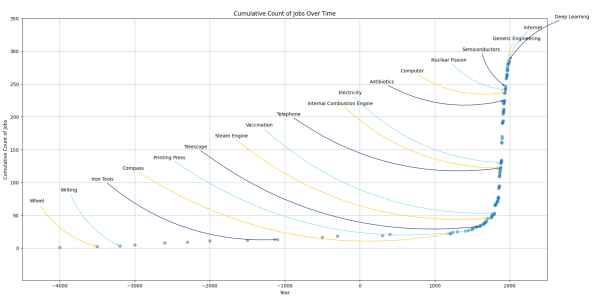
There was a time when job descriptions and the skills required were straightforward and consistent. A blacksmith needed to know how to work with different types of metals, a bank teller needed customer service skills, and a lawyer needed a deep understanding of the law. But jobs and their required skills are no longer static entities. They are now fluid, with skills and competencies that change in desirability and demand according to the pace of technological advancement. This is especially prevalent in the realm of knowledge work. Now, nearly all professionals must navigate a constantly shifting terrain. The driver of this transformation? Technology.
To fully appreciate this seismic shift, let’s travel back in time to the eras of bronze and iron, periods defined by humanity’s ability to manipulate natural materials. At that time, people in professions like wheelwright, blacksmith, or mason acquired specialized skills over years, even decades, of hands-on experience. Fast-forward to the Industrial Revolution, where we saw new jobs created for factory workers, and machines starting to do the work that was previously done by skilled human hands. Innovations such as the steam engine and the power loom initiated profound shifts in required skill sets and job categories. Jobs lost to the efficiency and speed of machinery were replaced by opportunities in assembly line production and industrial management. A thorough examination of job categories across decades reveals a fascinating trend: the rate of job creation in knowledge work progressively accelerates in lockstep with significant technological and industrial milestones.
For example, let’s consider the introductions of the printing press (1440), the telephone (1876), and the computer (1936). Each of these inventions dramatically reshaped the world and subsequently, the job landscape. With each technological advancement, a surge of new roles burgeoned: editors, librarians, and typesetters with the printing press; switchboard operators, customer service representatives, and telemarketers with the telephone; and system analysts, database administrators, software engineers, and more with the personal computer.

This explosion of new roles, particularly within the last half-century, results from a technological leap: the advent of the digital era and the internet.
The exponential era
Let’s walk through this quicksilver landscape: In the early stages of the internet, the demand for web developers skyrocketed. As companies identified the internet’s potential, previously unimagined roles like e-commerce specialists, digital marketers, and social media managers emerged. The World Wide Web effectively shrank the globe and brought audiences closer, and the need for content producers, cybersecurity specialists, and mobile app developers surged. The emergence and consolidation of major tech companies like Google, Facebook, and Amazon have further spurred diverse nontechnical roles ranging from SEO specialists to data privacy consultants.
Not too long ago, it was inconceivable in the realm of academia or professional institutes that the youth of today would aspire to become cloud engineers, Python developers, or specialize in search engine optimization. Yet, the unstoppable convergence of technology, innovation, and human ingenuity has made this a reality. It is clear, then, that the future of job creation and demand in the knowledge work sector will be tied to the pace of technological innovation.
The impact of AI
The relentless march of technology doesn’t come without concerns. Long-held anxieties about artificial intelligence and automation displacing jobs have intensified in recent years and become more acute. Traditional roles in sectors like manufacturing, customer service, and even law are increasingly augmented or even replaced by sophisticated machine learning algorithms. Yet, as history shows us, technological advancement doesn’t simply render old jobs obsolete—it paves the way for the creation of entirely new roles and job categories.
Like its precursors, the emergence of AI and automation sets the stage for the expansions of yet-to-be-defined skill sets and job descriptions. But, expecting immediate clarity is unrealistic. Each substantial technological leap first cultivates technical skills and job types crucial for establishing new industries, which eventually bloom into an array of nontechnical or semi-technical roles. Drawing from history, the internal combustion engine’s invention in the 1860s originally propelled a modest rise in roles tied to engine construction and operation. It wasn’t until companies like Ford transformed this innovation into a commercial commodity, like the Model T, that the roles of assembly line workers, car salespeople, and drivers were catalyzed—eventually establishing driving as a fundamental adult skill.
Skills of the future
As we accelerate into the age of AI, we need to think about what skills people will need to learn over the next decade. Although attempts at predicting the future have often proven futile (remember sci-fi writers’ unfulfilled predictions of flying cars), we can look to history for lessons on how job skills and technology have coevolved.
Recent advances in AI, including large language models, diffusion models, text-to-voice models, and other incredible feats of technology are still in the early stages, comparable to the 1860s when the internal combustion engine was first created. And most of the jobs created by those technologies are highly technical. This accelerated pace of change means that it won’t take long for widespread non- and semi-technical skills to be created. We already see companies hiring for prompt engineers to aid in building on top of tools like GPT-4 and Midjourney. The ongoing convergence of technology and creativity suggests the potential for new job roles like AI entertainment engineers, responsible for using AI animation tools to create movies and shows, or AI Wealth Management Specialists, leveraging AI-based finance tools to offer sophisticated financial services.
Navigating the skills gap
The swift rise of new roles and skills required to navigate our ever-evolving world brings forth its own particular set of challenges, notably the emergence of a “skills gap.” On one side, jobs like bank tellers, factory workers, truck drivers, and many more are at risk of being automated. On the other side, there’s a growing number of jobs in emerging fields that require specialized skills. For instance, roles like data scientists, cybersecurity specialists, and AI engineers are in high demand. These roles often require advanced skills and knowledge in areas that are still evolving or have only recently emerged. There are simply not enough people with the necessary skills to fill these roles, which widens the skills gap.
Addressing this disparity is one of the most formidable challenges of our era, calling for a comprehensive approach that encompasses the unified efforts of governments, educational institutions, organizations, and individuals.
First, the conventional “learn and work” model that has underpinned professional progression needs to transform into a more dynamic cycle of “learn, work, and re-learn.” It’s essential now, more than ever, for organizations to invest in frequently upskilling and reskilling their employees in preparation for the jobs of tomorrow. This demands a cultural shift at work that promotes lifelong learning, cultivates inquisitiveness, and nurtures intellectual agility to quickly adapt to new technologies.
Second, universities, colleges, and other learning institutions need a revolution in their curriculum design approach to mirror the shifting demands of the job market. With technological innovation showing no signs of slowing down, a paradigm shift in instructional design is required to keep pace with the accelerating rate of creation of new skills and jobs.
As we navigate the age of AI, we must be cognizant of the fact that we will need to evolve and adapt just as dynamically as our technological landscape does. It’s a brave new world, and the changes can feel overwhelming. But armed with a historical perspective, a willingness to embrace lifelong learning, and a commitment to adapt, we’re not just prepared for the future—we’re shaping it.
Tigran Sloyan is the cofounder and CEO of CodeSignal.






